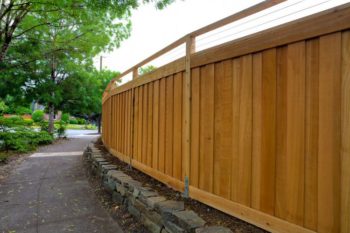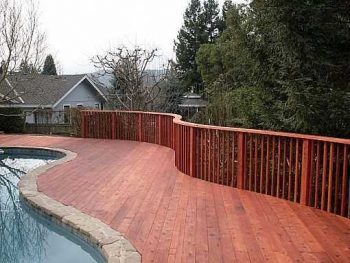Cedar and redwood are known and loved for many of the same qualities, all of which make them excellent building materials. These attributes include strength, beauty, straight grains, and minimal shrinkage.
Additionally, both timbers are naturally oily, creating a natural barrier to both moisture and wood-boring insects. However, there are a few notable differences, which should be considered prior to construction.
Here, we’re going to explore both the likenesses and differences between these two materials.


Cedar and redwood are known and loved for many of the same qualities, all of which make them excellent building materials. These attributes include strength, beauty, straight grains, and minimal shrinkage. Additionally, both timbers are naturally oily, creating a natural barrier to both moisture and wood-boring insects.
However, there are a few notable differences, which should be considered prior to construction. Here, we’re going to explore both the likenesses and differences between these two materials.
Cedar: The Basics
Cedar has been used in all manner of construction for a millennia, dating back to the Native Americans here in the US, and all the way back to biblical times throughout the world. The most common type here in the States is called western red cedar, and it is renowned for its color, durability, and sweet odor.
Its strength is readily evidenced in live trees, which are shade tolerant, thrive in a broad variety of environments, and can live for several hundred years. This durability is maintained even after being cut and processed.
Cedar For Fencing
Due to the timber’s oiliness, fencing projects will retain their shape and integrity without need for repair for far longer than most other wood types. It may be more expensive up-front, but even untreated cedar fences will still be standing tall and strong decades after being built.
Another quality the oil offers is that it makes the wood very receptive to weather treatments if you choose to do so. As a resin-free wood, it easily absorbs paints and varnishes of all types. Many choose a translucent finish in order to maintain the wood’s attractive reddish-brown hue.
Cedar For Decking
The qualities that make this wood such a great choice for fencing, also stand true for outdoor decking installations. Lightweight and famously strong, cedar decking typically lasts for 15-20 years. This is a bit less than you would expect with a cedar fence, but that is mainly because of the added wear and tear that comes along with being used as a walking surface.
Additionally, all wood is somewhat prone to eventual breakdown with repeated water exposure. The one instance where you may face a lifespan shorter than 15-20 years is in areas or regions where the platform receives frequent moisture and is slower to dry out (such as a heavily shaded porch). It needs to be treated every couple of years, but will still show some fading after several years of use.
Many do-it-yourselfers appreciate how lightweight cedar is, making it an easy material to work with. Another perk is that cedar is an eco-friendly choice as well. Not only is it an abundant resource, the fact that there’s not pretreating or processing means it actually has a “net negative” carbon footprint.
Redwood: The Basics
One unique feature redwood offers is that it is actually distinctly fire-resistant. Unfortunately, “new growth” redwood is less decay-resistant than wood from the original forests. It’s broadly available on the west coast, but less so in other regions, making it a bit more expensive than many alternatives.
Redwood timber actually comes in several different grades, based on different parts of the trunk. Deck heart is most commonly used for- that’s right- decking, because of its strength.
Construction heart is the next least expensive for upper-grade cedar, It has fewer blemishes than deck heart, but tends not to be quite as strong.
Clear heart and select heart are closer to the core, offering zero to limited knots. Architectural grade redwood comes directly from the tree’s core, and is typically used in finishing projects such as handrails due to its quality and attractiveness.
Redwood For Fencing
Redwood contains protective oils much like cedar, making it a safe option for outdoor projects. It’s denser than cedar, which means it’s a sturdier wood for long life, but also heavier and therefore a bit more labor-intensive.
Due to its weight, redwood fencing may need to be staked a bit more deeply if you live in a region that experiences heavy wind gusts. As for the aging process, it will typically turn blackish before fading to a silvery grey. This is a harmless feature, and is only mentioned in the spirit of aesthetic preferences.
Redwood For Decking
As a heavier wood, redwood is a superior material for decks that include multiple steps. This also holds true for decks whose roofs serve double-duty as the floor of an upper balcony. Dense building material is key to longevity for any structures bearing weight and heavy use.
Yet as a broader walking surface, both cedar and redwood hold up their sturdiness for years on end, due to their tight, straight grains. Again, one factor to consider is whether you’re doing the installation yourself or hiring professionals. Redwood weighs more than cedar, and will sometimes require pre-drilling to sustain its integrity in the construction process.
For larger projects, it’s good to know that redwood comes in a variety of grades, so you can do a cost-benefit analysis regarding quality and cost. One feature redwood has to offer, which justifies the expense, is that you can mix and match various wood grades for various portions of your deck. For instance, you could use deck heart or construction heart for the main flooring, but level-up to architectural grade for the finishing touches.

It’s great to hear that cedar is both lightweight and durable. My husband and I have been talking about building a deck off the back of our kitchen to use as an entertaining space. Cedar sounds like a great choice for this project since it is strong and eco-friendly.
Yes Cedar is economical and sustainable.
It really helped when you said that cedar decking lasts around 15-20 years as well as it being eco-friendly. This summer I want to build out more of my deck and had a roof part to it and I’m thinking about using cedar as the material. Thanks for the helpful information and I’ll be sure to continue researching about different prices and what would look best as an extension to my deck.
Cedar is not a good choice for a deck. I would recommend Epi or mahogany and Fir if you are going to paint it. Good luck
Thanks for telling me that cedar is a good choice for wooden fencing since it can last longer than other wood types without needing any repair. We can see how our dog badly wanted to go out but we just can’t seem to find the time to accompany her to a walk. It might be better to just hire ornamental cedar fencing services for our property so she can run freely in our front yard.
No matter what you choose, if it’s a natural wood like cedar, redwood, ipe, treated lumber
or douglas fir(less desirable for decking), you must have adequate ventilation beneath the deck surface. Moisture trapped beneath a poorly ventilated deck will cause cupping of the deck boards and promote rot and decay much sooner than with a well ventilated deck.
Could cedar & redwood be blended in a mosaic pattern on a sunny deck?
This could be tricky as the sizes are usually different. For example our cedar decking is 5/4×6 & our redwood decking is 2×6. Also, if you were to let it weather before restaining, then both would end up the same color after the maintenance staining is done at year 2 or 3 if in full sun.